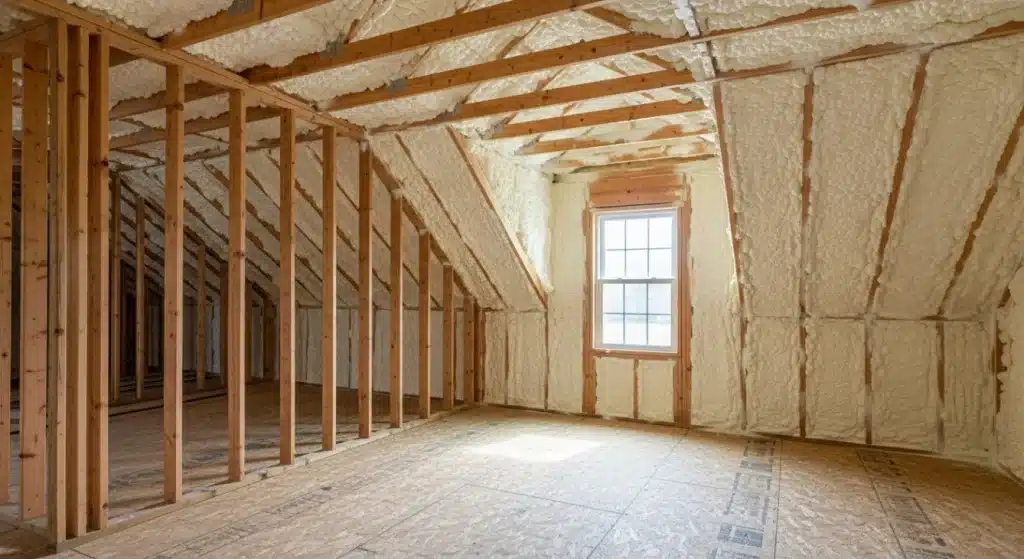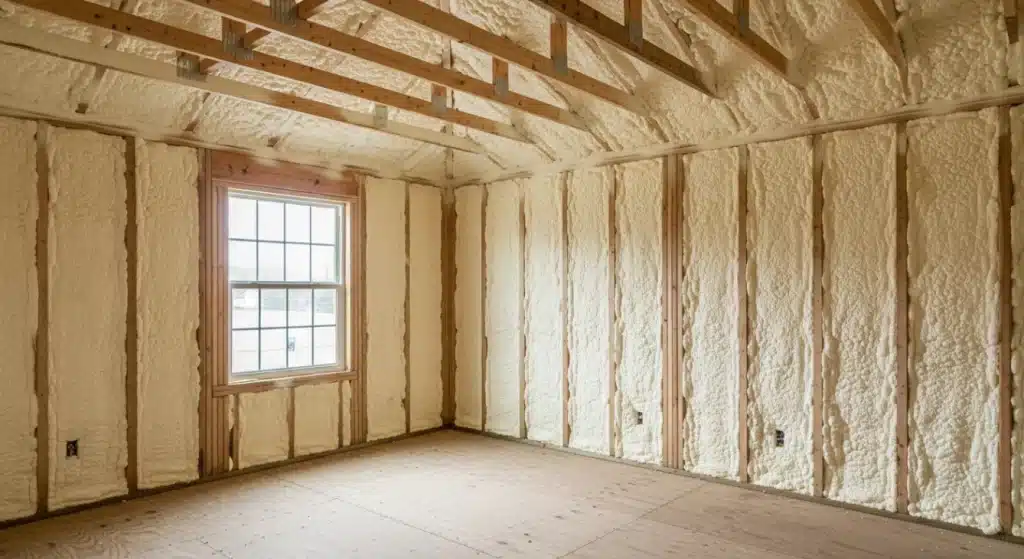Ice dams form when heat from inside a home melts snow on the roof, and that water refreezes at the edges in cold weather. Spray foam insulation stops this by creating a tight seal that keeps indoor heat from reaching the roof surface. It fills gaps and reduces air leaks, so less warmth escapes to melt snow above. This direct barrier helps maintain even roof temperatures and prevents the cycle of melting and refreezing.
Homeowners face costly damage from ice dams, like water leaks into attics or walls. This article explains how spray foam addresses the problem step by step. Practical details come from years of installing insulation in various climates, including Central California’s variable winters, where hands-on work with projects has shown that spray foam offers reliable protection against ice dams. Observations from sites in cooler regions confirm its effectiveness in keeping roofs cooler overall.
What Causes Ice Dams
Snow accumulates on roofs during winter. Warmth from the attic area melts the bottom layer of snow. Water runs down the roof and freezes into an ice ridge at the eaves where temperatures drop. Trapped water behind this ridge seeps under shingles and into the home.
Attics often have poor insulation or ventilation issues that allow heat to rise. In places like Fresno, rare cold snaps with snow can still lead to problems if homes aren’t prepared. Heat loss through unsealed spots worsens the issue.
How Spray Foam Insulation Works
Spray foam expands to fill cracks, joints, and voids in walls, floors, and ceilings. Open-cell foam provides an air barrier, while closed-cell adds moisture resistance. Both types block heat transfer better than traditional materials like fiberglass batts.
When applied to the underside of the roof deck, spray foam creates a continuous layer. This setup keeps attic temperatures closer to outside levels, so snow stays solid longer. In practice, homes with spray foam show fewer temperature swings in attics during cold weather.
Data from the U.S. Department of Energy indicates that spray foam can reduce air infiltration by up to 75%, cutting heat loss that leads to ice dams.
Bonus Tip
Check for drafts around recessed lights or chimneys before installation. Sealing these spots first boosts spray foam’s performance.
Benefits of Spray Foam for Ice Dam Prevention
Building on how spray foam works to block heat transfer, it acts as both insulation and an air seal. It stops warm air from reaching the roof sheathing, a key factor in ice dam creation. Unlike loose-fill insulation that settles and leaves gaps, spray foam adheres directly and stays in place.
In colder climates, it also controls moisture buildup in attics, which can contribute to ice formation. Closed-cell spray foam has an R-value of about 6.5 per inch, providing strong thermal resistance with less thickness.
A comparison from Oak Ridge National Laboratory shows spray foam outperforms other insulations in air sealing tests. Homes retrofitted with it report 20-30% lower energy use in winter, tying directly to fewer ice dam incidents.
| Insulation Type | R-Value per Inch | Air Sealing Ability | Moisture Resistance |
|---|---|---|---|
| Fiberglass Batts | 3.1-4.3 | Low (gaps common) | Poor |
| Cellulose | 3.2-3.8 | Moderate | Good |
| Closed-Cell Spray Foam | 6.5 | Excellent | High |
| Open-Cell Spray Foam | 3.6 | Excellent | Moderate |
This table highlights why spray foam stands out for preventing heat-driven problems like ice dams.
Market facts support these advantages. According to the Spray Polyurethane Foam Alliance, over 1.2 million homes in the U.S. use spray foam, with a 15% annual growth in adoption for energy efficiency.
Installation Process
Professionals start by preparing the attic space, removing old insulation if needed. They wear protective gear and use specialized equipment to spray the foam. It cures quickly, often within hours, allowing access soon after.
Focus on the roof deck, rafters, and any penetrations. In regions with varying humidity like Central California, closed-cell foam helps manage potential condensation. Full coverage ensures no weak points where heat can escape.
Bonus Tip
Schedule installation during milder weather to avoid complications from extreme cold or heat affecting the foam’s expansion.
Regional guidance matters here. Central California sees occasional freezing temperatures, especially in higher elevations nearby. Spray foam prepares homes for these events without over-insulating for constant cold.

Things to Consider Before Making a Decision
Assess the home’s current setup. Older roofs with ventilation problems may need updates first. Measure attic access and height to confirm feasibility.
Budget plays a role; initial costs run higher than batt insulation, but long-term savings on energy and repairs add up. Check local building codes for required R-values in California, typically R-30 to R-49 for attics.
Think about environmental impact. Spray foam uses chemicals that require proper ventilation during install. Professional application minimizes risks.
Weigh the roof’s condition. Damaged shingles or gutters can undermine insulation efforts, so inspect those too.
Common Questions
How much does spray foam insulation cost?
On average, spray foam costs $1–$2 per square foot installed. Final pricing depends on the foam type used and the size or complexity of the project area.
Can I install spray foam insulation myself?
DIY kits exist but are best for very small areas. Professional installation is strongly recommended to ensure even coverage, long-term performance, and to avoid health hazards from improper handling.
Bonus Tip
Combine spray foam with proper attic venting for best results in mixed climates.
Key Takeaways
Spray foam insulation prevents ice dams by sealing air leaks and blocking heat escape to the roof. It outperforms other materials in thermal and air barrier performance, backed by energy data. Consider local climate factors and home specifics for best results.
Evaluate your roof’s vulnerabilities, current insulation, and long-term energy goals before proceeding. Match solutions to actual needs for lasting protection.
Next Steps for Home Protection
Contact Supreme Spray Foam – Fresno at (559) 545-0800 or email [email protected] to discuss options tailored to the property. Schedule an assessment to identify ice dam risks and insulation needs. This step ensures informed choices for winter readiness.
Sources
- U.S. Department of Energy – Government resource on insulation types and their role in energy efficiency, including air sealing benefits.
- Oak Ridge National Laboratory – Research lab providing comparative data on insulation performance from building envelope studies.
- Spray Polyurethane Foam Alliance – Industry group offering market statistics and adoption trends for spray foam applications.
- National Association of Realtors – Real estate organization with reports on home improvements and their impact on property values.
Frequently Asked Questions
Can spray foam fix existing ice dams?
Spray foam prevents future ones by addressing heat loss at the source. For current dams, remove ice safely and repair any water damage first.
Is spray foam suitable for all roofs?
It works on most sloped roofs with accessible attics. Flat roofs or those with complex designs may need custom approaches.
How does it affect home resale value?
Energy-efficient upgrades like spray foam appeal to buyers. A study from the National Association of Realtors notes that such improvements can boost value by 5-7%.
What if the home has radiant barriers already?
Radiant barriers reflect heat, complementing spray foam’s sealing. Together, they provide layered protection against ice dams.
Does it void roof warranties?
Most manufacturers allow it if installed correctly without damaging shingles. Always confirm with your roofer.


